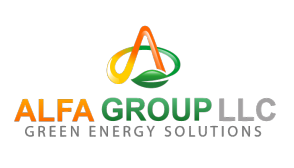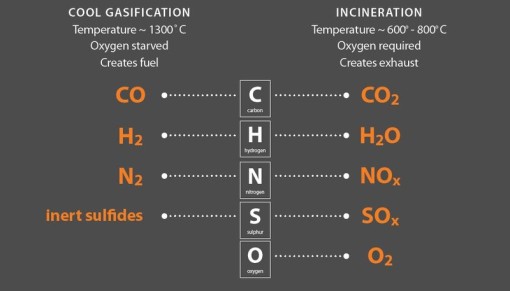The Process
The principle behind gasification is based on the conservation of energy, which states that energy matter cannot be created or destroyed but can be transformed. The waste-to-energy facility comprises three main sections: (1) gasification, (2) syngas cleaning, and (3) power generation. The plasma gasifier utilizes plasma torches powered by an external energy source (electricity) to heat the waste to extremely high temperatures in an oxygen-starved atmosphere, containing less oxygen than required for complete combustion.
At such elevated temperatures, the chemical bonds in the waste material break down into simple molecules, primarily hydrogen (H2) and carbon monoxide (CO).
This resulting mixture, primarily consisting of carbon monoxide and hydrogen gases, is commonly referred to as synthesis gas or "syngas." Syngas has versatile applications, including direct power generation, the production of transportation fuels like ethanol, green hydrogen, and diesel, as well as the generation of process steam or the offsetting of natural gas usage in industrial facilities. The quantity of syngas generated depends on the type of feedstock used in the process, with high carbon content feedstocks yielding more syngas.
The inorganic materials in the waste exit from the bottom of the gasifier at temperatures around 3000 degrees Fahrenheit. This process eliminates potential pollutants, destroys hazardous compounds, and encapsulates minerals and trace metals within a non-toxic inert solid similar to obsidian, a volcanic glass. The metal content in the glassy slag forms layers that can be separated, captured, and recycled, including valuable metals like gold, aluminum, and copper.
The syngas cleaning section of the facility focuses on purifying the syngas to achieve a level of purity similar to or better than that of natural gas. This rigorous cleaning process is vital to eliminate environmentally toxic elements and safeguard human health and the environment. The syngas cleaning process involves several steps, including the use of:
- Venturi Scrubber
- Spray Tower
- Wet Electrostatic Precipitator
- Condenser
- Compressor
- Activated carbon beds
- Sulfur removal system
Once this purification process is complete, the syngas is thoroughly cleaned and ready for use as a fuel in the power generation section of the facility or as a feedstock for the production of transportation fuels like ethanol or hydrogen.
When the primary goal is electricity generation, the syngas serves as a fuel in a high-efficiency combined-cycle power plant, featuring both a gas turbine and a steam turbine. This power plant generates electricity for internal use (approximately 20%) and for sale to the public grid (approximately 80%). Emissions from the combined-cycle power plant are typical for facilities of this nature, known for being among the cleanest power plants in existence.
For a more comprehensive understanding of the process, a detailed description is available in an independent report by Juniper Consultancy Services, Ltd. This report provides a candid, in-depth examination of the technology provided by Alter NRG and Westinghouse Plasma Corporation, including emissions data from existing facilities. It's important to note that the system design proposed in this context includes significant improvements compared to the design of existing facilities currently in operation.



